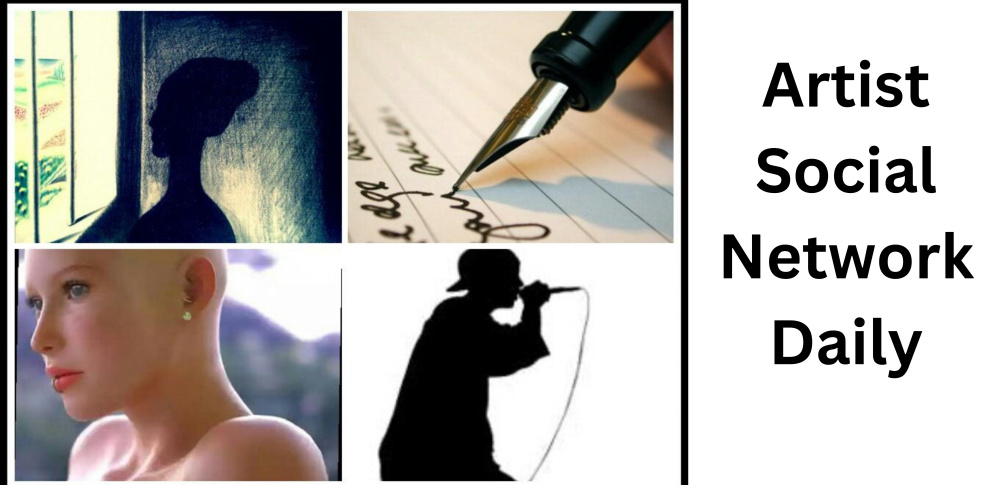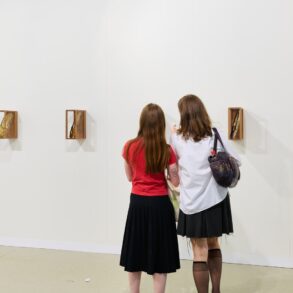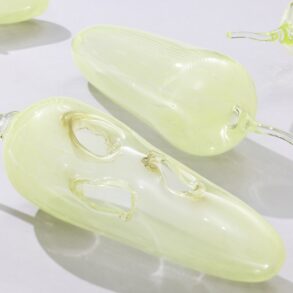
In E.T.A. Hoffmann’s short story “The Sandman” (1817), a gothic tale of psychological unraveling, a young man called Nathaniel is haunted by visions of a nightmarish character who steals children’s eyes. Nathaniel, believing the Sandman has murdered his father, becomes unable to distinguish fantasy from reality, eventually falling in love with a mechanical doll named Olympia. When he sees Olympia torn apart by her creators, her eyes strewn on the ground, he has a complete breakdown.
For Anna Perach, an artist whose work explores how myths and other cultural narratives shape our ideas about ourselves, reading “The Sandman” felt like rifling through a treasure trove of material. She was especially fascinated by Olympia, interpreting her as a symbol of the often-repressed “monstrous feminine”—the chaotic and irrational aspects of the self that have been rigorously controlled and denied in patriarchal societies. “Storytelling is my main interest,” the Ukraine-born artist told me during a recent visit to her studio at Gasworks in South London, where she had her first institutional exhibition last year. “I identify as a woman, and I often work with women, so the themes and content I am drawn to tend to be related to that experience.”
Since graduating in 2020 with an MFA from Goldsmiths in London, Perach has speedily built an impressive resumé with group and solo shows at galleries including Edel Assanti in London and ADA in Rome. Her research-heavy projects have taken on subjects such as the Victorian side-show fixture of “spidora” (half-spider, half-woman) and 18th-century female wax cadavers known as “anatomical Venuses.” Perach riffs on these sources, often by creating most “wearable sculpture”: colorful life-sized figures, heads, and bodily appendages made from a textile called tufted yarn. Several of these are on view through June 24th in “A Leap of Sympathy” at Richard Saltoun in London (the show will later travel to the non-profit East Gallery in Norwich). The sculptures can be displayed statically in the gallery or activated through performance—an idea that Perach thinks may be rooted in her brief post-BA studies in classical theater and acting.
Initially, Perach was intimidated by how extensively “The Sandman” had already been explored by others, not least Sigmund Freud, who used the story as a key reference in his famous essay on The Uncanny. Then she came across Japanese roboticist Masahiro Mori’s 1970 essay, “The Uncanny Valley,” which describes how we switch from empathy to revulsion when we encounter robots that look almost human, but not quite. This fascinated Perach, who has long been preoccupied with psychology—she has a diploma in art therapy and counselling and still maintains a therapeutic practice. Her current show’s title is borrowed from philosopher Henri Bergson, who argued that it was through a leap of intuition or “sympathy,” rather than empirical knowledge, that we apprehend other people’s humanity. What is reality, anyway?
Central to the exhibition is Olimpia (2025), a work comprising two matching wearable sculptures: female figures in flouncy Rococo-inspired dresses. Tufting, a technique which Perach first came across at Goldsmiths, is more often used in carpet-making than dress-making. But Perach was attracted to it, she said, because it reminded her of the “Soviet-inspired home,” lined with carpets on the walls and floors, where she grew up. She was also interested in the textile’s associations with feminine-coded domesticity, and the notion of “sweeping things under the rug”—in other words, repression.
The paired sculptures could be interpreted as representing Nathaniel’s two love interests in “The Sandman”: Olympia and Clara, his fiancée since childhood. The latter is presented as a paragon of Enlightenment-era rationality, cheerfully and unremittingly sane in her continued assurances to Nathaniel that his fears are all in his mind. “The dichotomy between rationality and intuition, the mind and the body, is a link in a lot of my work,” Perach said. For the exhibition, she worked with a team of recurring collaborators—including choreographer Luigo Ambrosio and composer Laima Leyton—to develop a performance in which the two figures engage in a kind of pas de deux. One of the bodies is worn by a live performer, Maria Sole Montaci, while the other is animated using robotics.
Spinning further away from the source material, the show also features a series of haunting watercolor assemblages that reimagine Olympia’s plot, casting her as a pair of twins separated in childhood. Perach described the images as “a visualization of the process of repression in which the self is split into two parts.” (Perhaps, then, the two tufted figures are both also Olympia—the viewer is left to decide.) A series of tufted heads mounted on wooden poles, collectively titled “The Uncanny Valley,” allude to another monstrous female: Baba Yaga, a wicked, child-eating witch from Russian folklore whose home is surrounded by severed heads on sticks.
Just as creepy is a pair of life-sized ribcages (Ribs 1 and Ribs 2, both 2025) made from pale pink glass with dark red splotches like dried blood. The sculptures are presented “face to face” in recessed spaces on opposite sides of the gallery: the imagined hard interiors of the soft, tufted sculptures. As Freud argued, the uncanny is not always easy to define—but, as Perach’s work proves, you know it when you see it.
This post was originally published on this site be sure to check out more of their content




